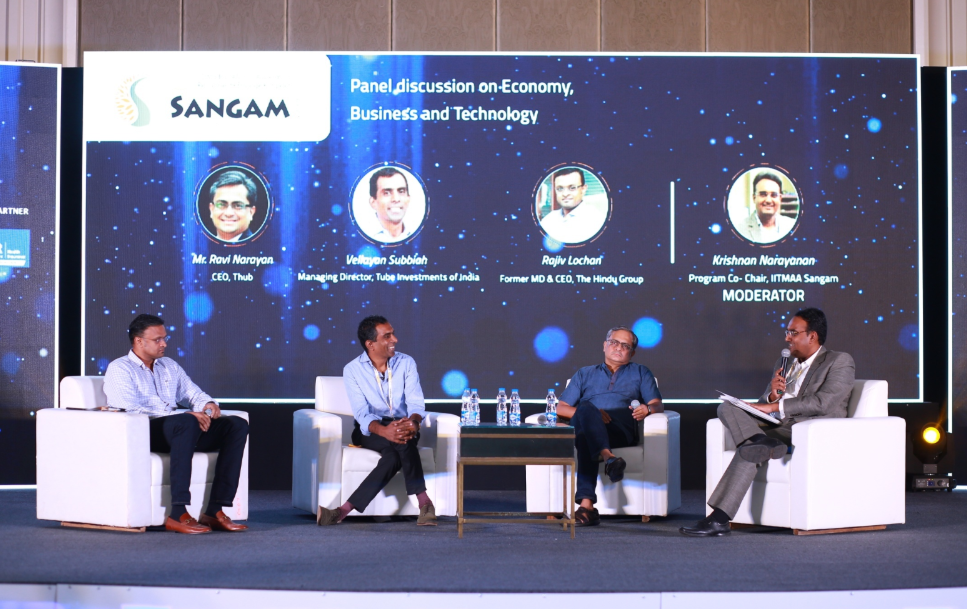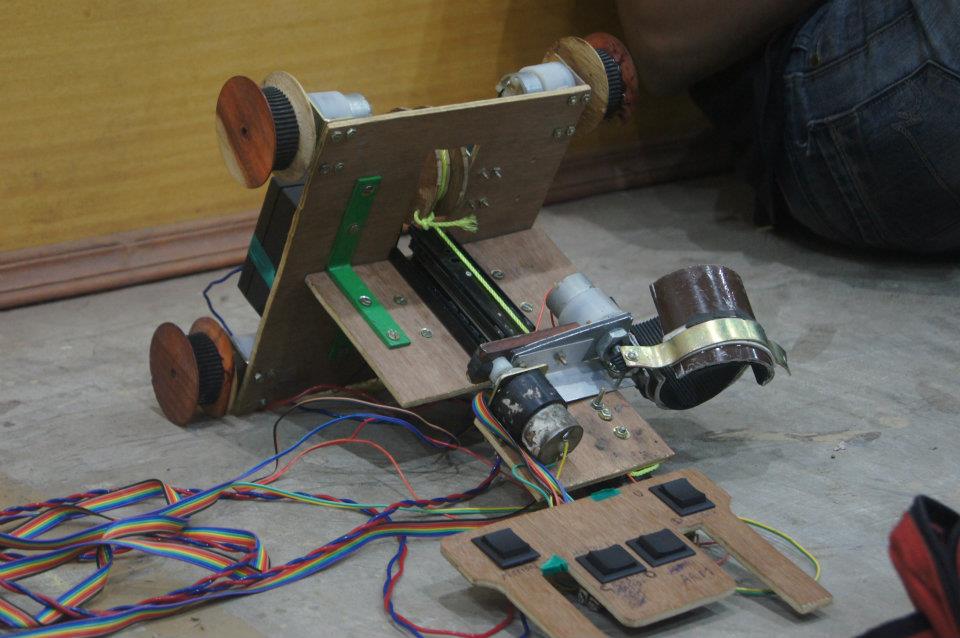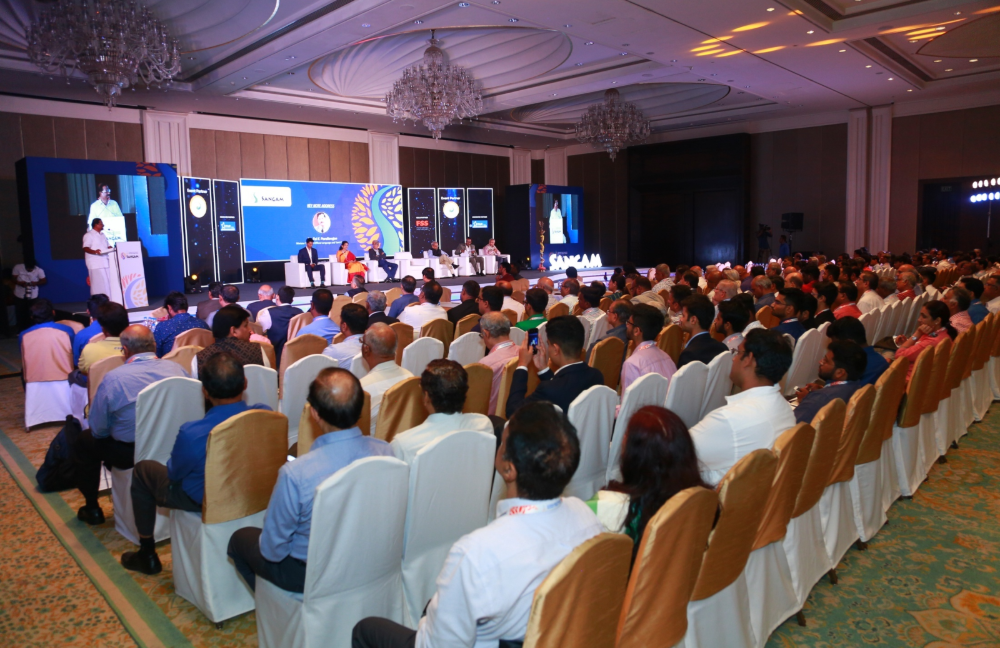This article is a report on one of the five panel discussions at the 2019 IITMAA Sangam Confluence. The following article appears in an abridged form here.
India is a land of diversity in its truest sense. Today, India stands 7th in the world in terms of gross GDP, has the 2nd largest IT industry in the world, has one of the best Thorium based nuclear technology and boasts of the most cost effective space programs. However, in the shadows, India lags as far as 177th out of 180 countries in green technology, 47th off 223 in infant mortality rate and 130th in overall Human Development Ranking: in neighborhood of countries we might never have heard of. How will India transform itself in the coming decade? What can we expect from our country in 2030? Mr Rajiv Lochan, director of Sundaram Finance, Mr Vellayan Subbiah, Managing director at TI Cycles and Mr Ravi Narayan, CEO of T-Hub gathered on the morning of 14th September 2019 for an enlightening exchange of thoughts on the same. The discussion was moderated by Mr Krishnan Narayanan, co-founder and president of itihaasa Research and Digital.
What can we expect India to look like 10 years from now?
A currently develops technologically when people invest time and effort in innovation, rather than blindly following conventions. Currently, India stands 52nd in Global Innovation Index while China is way above at 14th. However, unlike the period post liberation, our country has grown to be much younger. India tops the world rankings in population of youth with 356 million young individuals – more than the entire population of USA (about 327 million). Our youth are continuously adapting to the changing global scenario and are slowly but positively moving towards being leaders at innovation. India has seen an unprecedented level of technological advancement and adoption in the last 30 years than ever before, which points towards a prosperous future. However, we live in a dichotomy with our societal sphere nearly in the ruins. Economic fluctuations among other factors often lead to civil unrest. It is a collective responsibility of our people to proactively deal with economic, social and political challenges.
We must also draw our attention to a largely ignored sector of our economy – agriculture. With more than 95% of our farmers remaining in debt for life, it is imperative to adopt better cultivation techniques and restore soil and water quality. With adoption of advanced agricultural techniques, India’s food basket is gradually improving. In the past few years, we have cultivated more fruits and vegetables than grains, which also improves our exports. To improve the conditions of our cultivators, it is necessary to incentivize tax free capital investment in agriculture and improvement of supply chains. Organizations like FCI attempt to reduce the amount of food wastage in various stages of supply chains, which reckons to about 20% of the production off late.
Another major epidemic that has taken Indian youth by storm is that of entrepreneurship. With 0 registered startups in 2006, we have over 7000 tech startups and 20,000 non-tech startups in our country today. Entrepreneurs contribute to about 38% of our GDP and 40% of total manufactured goods. Most of these ventures mushroom around B2C opportunities. Despite the explosive numbers, our journey of innovation has just begun. More and more organizations are playing incubators to these startups in the form of Tech parks. Startup opportunities enable our youth to solve modern problems with state-of-the-art technology available in the market. Small ventures often succeed in developing efficient and profitable ecosystems, which can be scaled up to better visible businesses. That being said, we must agree to Mr Ravi Narayan’s assertion “… we should not only be consumers but producers of technology.”
It is easier said than done to improve the state of supply chains. What are the problems faced by the agricultural sector in this regard? Can AI help in any way?
Mr Vellayan made a point very clear – the term “artificial intelligence” is grossly overused and is not required in agriculture.
“Agri[culture] doesn’t need AI. It only needs BI – basic intelligence”
In the past, the political scenario of our country was not very supportive towards the progress of agriculture. Supply chains were mismanaged to the extent where vegetables costing Rs 40/kg leaving from Ooty often reached Chennai priced at Rs 150/kg. However, a lot of changes have been underway in recent times, and for the better. Numerous entrepreneurs with supply chain startups willing to associate with IITs for better ideas and credibility. Mr Vellayan suggested a model which would help cultivators improve their livelihood.
- Attract external capital
- Every investor rents a section of the land, based on capital invested
- The investors get 10% of the profit generated from the land
- The remaining profit helps farmers invest in better technology
This is an example in which a simple ecosystem can be developed, made profitable and scaled.
What about the condition of healthcare and education?
In the case of our country, affordability for people has gone up, but the cost of living stays the same. Owing to this, household jobs turn out to be more lucrative for women that to work. However, a generation shift has been observed recently, which is slowly improving the participation of women in the economy. A large part of this can be attributed to better educational facilities now available for women, unlike a few decades ago. Our country has drawn inspiration from education practices in the world, where there are often more female students than male students.
Our country has slowly risen to become the cardiac disorder, cancer and diabetes capital of the world. Obesity rates are fast increasing, which sets the alarms ringing for health authorities in the country. 70% of our country’s consumption is rice and wheat – a practice majorly contributing to this situation. Our soils have potential to grow a variety of crops, but our demand remains excessively skewed towards grains. Investing in improving soil quality and availability of irrigation resources with the help of advanced technology can help effectively tackle this problem to a reasonable extent. If this aspect remains unattended, we are encouraging a fragile ecosystem which puts the following 2 generations at risk.
How early are we in our innovation journey?
A study on the 7 largest economies in the world revealed that India is the fastest digitizing country in the world. Our monthly information transfer clocks in at about 8.3 gigabits, way above that of China at roughly 5 gigabits. The number of people owning smartphones is skyrocketing, which has compelled the government to provide a stable and transparent database infrastructure. Developments in this sector has eased official processes to a large extent, thus improving transparency and accessibility.
In the last century, India’s contribution to world’s GDP was a whopping 20%. Post industrialization, this figure quickly plummeted to about 2%. This is a clear indication that adopted technology plays a very important role in development of a country’s GDP. Although startups contribute to 38% of our GDP, more than 80% do not use web for business. In fact, only 2-3% of them use technology to build anything useful to their business. Hopefully, this figure will improve as more entrepreneurs become aware of the benefits of fast-improving technology in global & domestic markets. Another important factor is the amount of money invested in internal research and development. Currently, this figure is about 0.8% of GDP, compared to the United States and China spending about 2.7% and 2.1% of their GDPs in research activities. Our country has a lot more potential without doubt. We can develop better technology for both internal and global markets. Unlike China, we have no barriers limiting our R&D to internal use. With enough incentive from the government and educated individuals, our country can become a leader in research and development activities.
Will venturing early into entrepreneurship hamper academic activities of students?
Our system has always worked towards creating skills to get a job. It is important for us to understand and change this mindset. Entrepreneurship provides purpose to our education – compelling students to solve real world problems the hard way. This not only helps students appreciate the skills they develop, but also encourages them to defy odds, take risks and be unafraid to rebound after failures.
Comments on the situation of the automobile sector?
Contrary to what is projected by the media, our automobile industry in doing well, with lot of profits being made. The recession is due to Indians not willing to own more automobiles, which has compelled the industries to look into exports. Latest technology like Electric Vehicles (EV) are being researched and the industry is trying its best to adapt to it. This might take up to 20-30 years of development. It is best to leave the automobile sector as it is.




